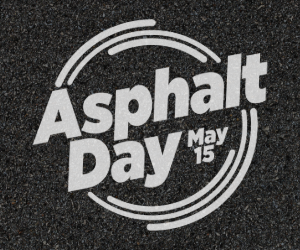
Reflection cracking is a common and significant pavement distress. It is the result of horizontal and vertical movements at joints and cracks in underlying concrete pavements.
Temperature changes in the pavement cause the concrete slab to contract and expand. Cooling causes the opening of joints and cracks and results in tensile stress developing in the asphalt overlay above these openings. When the stress exceeds the tensile strength of the asphalt overlay a reflection crack forms. The key to delaying or eliminating reflection cracking is to minimize or eliminate the stresses and deformations developed in the overlay.
Fractured slab technologies are widely recognized as being effective for addressing reflection cracking concerns in asphalt overlays. These techniques include cracking/seating, breaking and seating and rubblization. Cracking/seating and breaking and seating minimize the size of the concrete slabs and then seat the broken concrete pieces.
Rubblization eliminates the slab movement by converting the old concrete pavement to aggregate-size pieces. The resulting rubblized pavement layer functions as an aggregate base course.
Cracking/seating
Cracking/seating minimizes movement of the underlying pavement by reducing the effective slab length and seating the broken concrete pieces. The old concrete is typically broken using a drop hammer. Seating is done with a heavily weighted rubber-tire roller.
Cracking/seating is used on jointed plain (unreinforced) concrete pavements. The slabs must be cracked through the entire layer depth to be effective in controlling cracks from reflecting through the overlay. Cracking/seating is an effective technique for addressing unstable slabs and working cracks or joints within the pavement.
The overlay thickness should be determined using normal thickness design procedures and should account for the support value of the broken concrete. A minimum overlay thickness of 5 inches is recommended. A sub-drainage system may be needed to drain water away from the pavement structure.
Typical crack/seat specifications require breaking the concrete into roughly 1.5- to 3-feet pieces. Better performance is generally found by breaking the concrete into smaller pieces. Equipment for cracking the pavement includes pile drivers, guillotine hammers, whip hammers and impact hammers. A test section and pit should be used to establish that the equipment and effort is cracking the old slab through its full depth.
After the old pavement is cracked, the pieces must be fully seated. Seating or rolling of the cracked pieces is intended to interlock the fractured pieces and to seat the pieces firmly onto the base and into any voids under the old slab. Seating is typically done with a large (50-ton) pneumatic roller. Typically, two passes of the roller are required; excessive rolling should be avoided to prevent loss of interlock of the pieces. Rolling should not be done while the sub-grade is saturated. Every effort should be made to place at least one lift of the overlay before the pavement is rained on. Before the overlay is placed, the cracked pavement should be tacked. The overlay should not be exposed to traffic until at least 5 inches of asphalt are in place.
Break and seating
Breaking and seating is similar to cracking /seating. Breaking and seating is appropriate for rehabilitating reinforced concrete. This process typically breaks the old slab into smaller pieces than the cracking technique, and the fractures should be visible without wetting the pavement to see the breaks.
Typical broken pieces are 12 to 18 inches. It is critical that the reinforcing steel be de-bonded from the old concrete. The same type of heavy pneumatic roller is used for the seating process, except that additional passes, totaling about five to seven passes, are applied to break the concrete’s bond to the steel and to seat the broken pieces. Drainage and thickness design considerations are the same as for cracking and seating.
Rubblization
Rubblization is the process of converting the old concrete pavement into small, interconnected pieces, which serve as a base course for a new asphalt pavement. A properly executed rubblized pavement will not act as a slab, eliminating reflection cracking.
Rubblization is suited for both reinforced and plain, unreinforced concrete pavements. It can be used on continuously reinforced pavements. Generally, thin slabs over poor sub-grade soils are not good candidates for rubblization. Like cracking and breaking and seating, drainage is important. Under-drain systems are typically installed before rubblizing the pavement. These drains serve two purposes. Before the pavement is broken, the drainage system allows the sub-base to dry and stabilize. Also, during the overlaid pavement’s life, water is drained from under the pavement structure.
Two types of equipment, multiple-head breakers and resonant pavement breakers, are used to rubblize the concrete. The multiple-head breaker uses a series of drop hammers to rubblize the slab. Fracturing of the slab is controlled by a combination of drop height, frequency of impacts, and forward speed of the machine. The multi-head breaking process includes using a modified, steel-wheel roller, with a Z-grid pattern attached to the roller surface, to break any elongated particles on the surface into more cubical shapes and provide a uniform surface. Typically two passes of this modified roller is used, followed by a pneumatic roller, and often a tandem, vibratory roller is used to accomplish final seating.
Rolling is intended to tighten the surface and to provide a smooth surface for paving. Excessive rolling can reduce particle interlock and weaken the rubblized layer.
The resonant breaker uses high frequency and low amplitude blows generated by an oscillating beam and applied through a breaking shoe. Diagonal cracks are formed through the entire depth of the old slab, while the concrete near the surface of the slab is crushed into smaller particles. The broken concrete is de-bonded from any reinforcing steel and remains tightly interlocked.
Rolling of concrete rubblized by a resonant breaker should be done by a tandem vibrating roller. Two to four passes should be sufficient.
Prior to paving, any area found to be yielding or unstable should be removed and replaced with an asphalt base mix or an aggregate base. Any reinforcing steel or mesh which works its way to the surface must be removed.
Placement and compaction of the asphalt overlay is done with conventional equipment and practices.
Additional sources
More detailed descriptions regarding fractured slab technology are available in the Asphalt Institute’s manuals “MS-4 The Asphalt Handbook” and “MS-17 Asphalt Overlays for Highway and Street Rehabilitation.” A recent national research project conducted by the Asphalt Institute documents the state of the knowledge in rubblization technology for airfield pavements and provides practical guidelines in using rubblization with rehabilitating airfields. This report can be found at www.aaptp.us under project 04-01.
Dwight Walker is a contributing editor for Asphalt magazine and a consulting engineer specializing in asphalt materials and construction.














